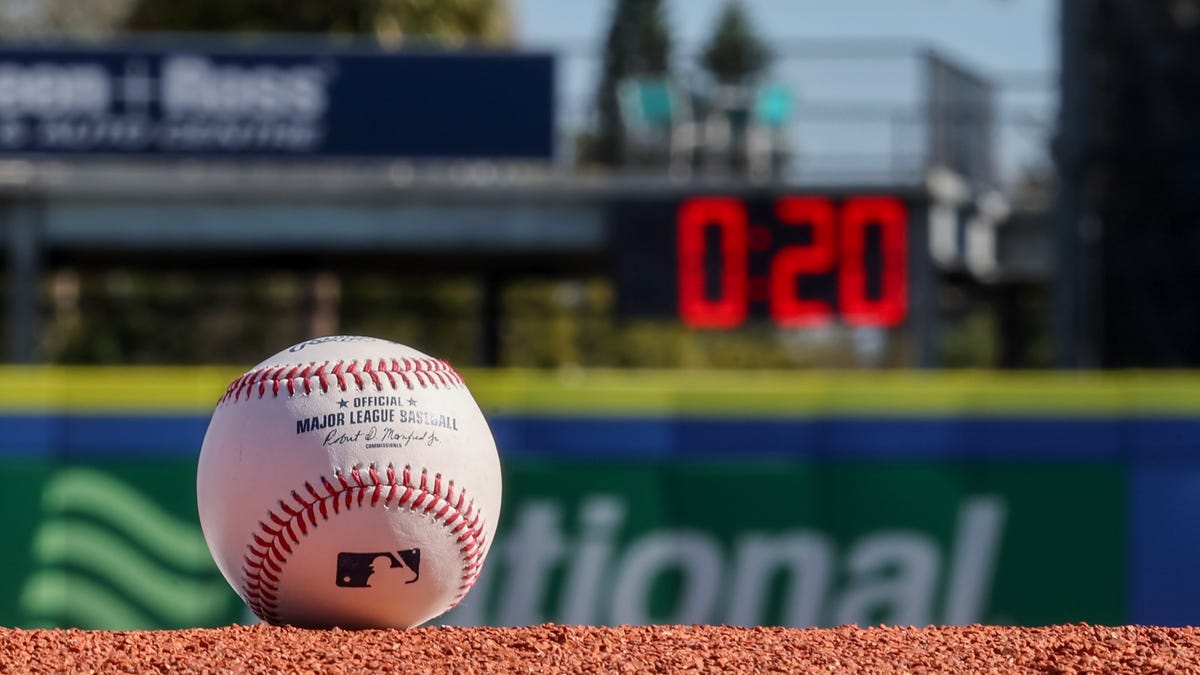
A new baseball rule limits the time a pitcher can take between pitches.
Mike Carlson/Getty Images
‘Tis the season when hearts of baseball fans are warmed by the magical words, “pitchers and catchers reporting.” Major League Baseball kicks off spring training this week, and the first games will start on Feb. 24 in Arizona’s Cactus League.
Starting this spring training, however, baseball will look quite a bit different than in years past.
Despite having a somewhat stodgy reputation, MLB has adapted its rules over the years to changing circumstances. The league banned the spitball in 1917, added the designated hitter in 1973 and even lowered the pitcher’s mound in 1969.
The 2023 season brings three big rule changes to professional baseball in an effort to shorten game times, increase offense and improve safety. Learn all about the new MLB rule changes this year and how they will be implemented.
What are the new rules in Major League Baseball for 2023?
In an effort to speed up games, encourage base stealing and prevent stifling of power hitters, Major League Baseball is implementing three main rule changes for the 2023 season:
- Introducing a new pitch timer
- Increasing the size of the bases
- Eliminating the “defensive shift”
All three rules were tested in MLB’s minor league systems in 2022.
How does MLB’s new pitch timer work?
Starting in 2023, pitchers will now have a time limit to deliver their pitches — 20 seconds with runners on bases or 15 seconds when the bases are empty.
If a pitcher does not start to throw before the timer ends, a ball will be called.
Pitchers will also be limited to only two “disengagements from the mound” per batter when a runner is on base. That means a pitcher can only try to pick off the runner or step off the rubber twice. A pitcher may disengage a third time, but unless an out is recorded or the runner advances a base, the disengagement will result in a balk, meaning all runners advance one base.
There will also be a 30-second timer in between batters, and hitters must enter the batter’s box by the 8-second mark or be charged with an automatic strike.
The pitch timer is designed to speed up the pace of baseball games, which averaged more than 3 hours in 2022. During the rule’s testing in the 2022 minor-league seasons, games were 25 minutes shorter on average than before the rule.
New limits on the number of allowed pickoff attempts could also encourage more base stealing.
How is MLB changing the size of bases in baseball games?
The league is expanding the size of bases in 2023, beefing them up from 15 inches square to 18 inches square. Home plate will remain the same size.
The main reason for bigger bases is safety. The larger area will give fielders and runners more room to share the base without crushing each other’s feet.
However, increasing the bases by 3 inches on each side means that the bases are 4 1/2 inches closer to each other. The distance from home plate to first and third base to home will be 3 inches shorter. Those few inches could be significant for base stealers or for “bang-bang” plays where the ball and the runner reach the base at nearly the same time.
What is the defensive shift and why is MLB ending it?
In recent years, a baseball tactic called the defensive shift has been increasingly adopted around Major League Baseball. A team will move one or more infielders to the opposite side of the diamond to defend better against “pull hitters” — batters who frequently hit to right field if left-handed or left field if right-handed.
Because the first baseman is required to cover first base, defensive shifts have been used in the past occasionally against star left-handed hitters, but the practice became widespread in the 2010s when managers realized that many players often hit in the same direction.
A new MLB rule for 2023 will end the most common defensive shift of moving a shortstop over to second base or second baseman over to short, with one of them in shallow outfield. Starting this season, teams must have at least four infielders at all times, with two infielders on each side of second base. Those four infielders must also be standing with both feet on the infield dirt. Teams can still bring in an extra outfielder to have five infielders.
According to MLB, the reason for the defensive-shift rule change is to “improve the likelihood of balls in play leading to more traditional outcomes and to showcase the athleticism of rangy defenders up the middle.” The league notes that batting percentage on balls in play in 2022 was .290, seven points lower than a decade earlier.
What other baseball rules are changing in 2023?
The three rules above are the big changes, but MLB is also expanding the “ghost runner” in extra innings to playoff games and making the rule permanent. Beginning in the 10th inning, each team starts with a runner on second base.
MLB is tightening the restrictions on position players pitching, too. In order for a non-pitcher to take the mound, one of three criteria must be met: the game is in extra innings; the player is on a team losing by eight runs or more; or the player is on a team winning by 10 runs or more in the ninth inning.
All of the rule changes for 2023 will take effect from the very first games of spring training, with no grace period, the league said. Be patient with the umpires this year — the first games with the new rules could be a total mess.
